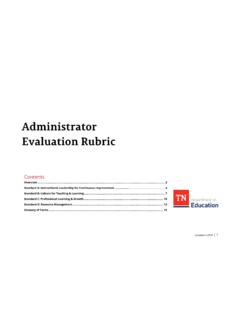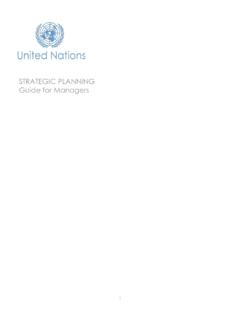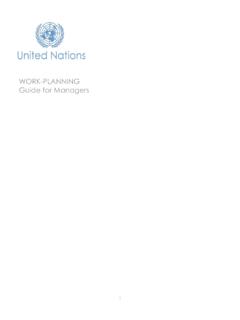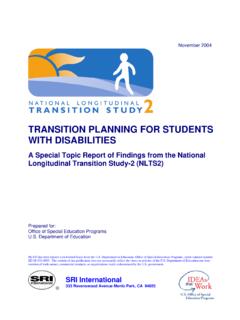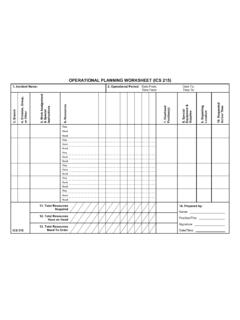Transcription of General Educator Rubric: Planning - TEAM-TN
1 General Educator rubric : Planning 7 Significantly Above Expectations (5) At Expectations (3) Significantly Below Expectations (1) Instructional Plans Instructional plans include: measurable and explicit goals aligned to state content standards; activities, materials, and assessments that: o are aligned to state standards, o are sequenced from basic to complex, o build on prior student knowledge, are relevant to students lives, and integrate other disciplines, and o provide appropriate time for student work, student reflection, and lesson unit and closure; evidence that plan is appropriate for the age, knowledge, and interests of all learners; and evidence that the plan provides regular opportunities to accommodate individual student needs.
2 Instructional plans include: goals aligned to state content standards, activities, materials, and assessments that: o are aligned to state standards, o are sequenced from basic to complex, o build on prior student knowledge, and o provide appropriate time for student work, and lesson and unit closure; evidence that plan is appropriate for the age, knowledge, and interests of most learners; and evidence that the plan provides some opportunities to accommodate individual student needs. Instructional plans include: few goals aligned to state content standards, activities, materials, and assessments that: o are rarely aligned to state standards, o are rarely logically sequenced, o rarely build on prior student knowledge, and o inconsistently provide time for student work, and lesson and unit closure; and little evidence that the plan provides some opportunities to accommodate individual student needs.
3 Student Work Assignments require students to: organize, interpret, analyze, synthesize, and evaluate information rather than reproduce it, draw conclusions, make generalizations, and produce arguments that are supported through extended writing, and connect what they are learning to experiences, observations, feelings, or situations significant in their daily lives both inside and outside of school. Assignments require students to: interpret information rather than reproduce it, draw conclusions and support them through writing, and connect what they are learning to prior learning and some life experiences. Assignments require students to: mostly reproduce information, rarely draw conclusions and support them through writing, and rarely connect what they are learning to prior learning or life experiences.
4 Assessment Assessment plans: are aligned with state content standards; have clear measurement criteria; measure student performance in more than three ways ( , in the form of a project, experiment, presentation, essay, short answer, or multiple choice test); require extended written tasks; are portfolio based with clear illustrations of student progress toward state content standards; and include descriptions of how assessment results will be used to inform future instruction. Assessment plans: are aligned with state content standards; have measurement criteria; measure student performance in more than two ways ( , in the form of a project, experiment, presentation, essay, short answer, or multiple choice test); require written tasks; and include performance checks throughout the school year.
5 Assessment plans: are rarely aligned with state content standards; have ambiguous measurement criteria; measure student performance in less than two ways ( , in the form of a project, experiment, presentation, essay, short answer, or multiple choice test); and include performance checks, although the purpose of these checks is not clear. General Educator rubric : Environment 8 Significantly Above Expectations (5) At Expectations (3) Significantly Below Expectations (1) Expectations Teacher sets high and demanding academic expectations for every student. Teacher encourages students to learn from mistakes. Teacher creates learning opportunities where all students can experience success. Students take initiative and follow through with their own work.
6 Teacher optimizes instructional time, teaches more material, and demands better performance from every student. Teacher sets high and demanding academic expectations for every student. Teacher encourages students to learn from mistakes. Teacher creates learning opportunities where most students can experience success. Students complete their work according to teacher expectations. Teacher expectations are not sufficiently high for every student. Teacher creates an environment where mistakes and failure are not viewed as learning experiences. Students demonstrate little or no pride in the quality of their work. Managing Student Behavior Students are consistently well behaved and on task. Teacher and students establish clear rules for learning and behavior.
7 The teacher overlooks inconsequential behavior. The teacher deals with students who have caused disruptions rather than the entire class. The teacher attends to disruptions quickly and firmly. Students are mostly well behaved and on task, some minor learning disruptions may occur. Teacher establishes rules for learning and behavior. The teacher uses some techniques, such as social approval, contingent activities, and consequences, to maintain appropriate student behavior. The teacher overlooks some inconsequential behavior, but at other times, stops the lesson to address it. The teacher deals with students who have caused disruptions, yet sometimes he or she addresses the entire class. Students are not well behaved and are often off task.
8 Teacher establishes few rules for learning and behavior. The teacher uses few techniques to maintain appropriate student behavior. The teacher cannot distinguish between inconsequential behavior and inappropriate behavior. Disruptions frequently interrupt instruction. Environment The classroom: welcomes all members and guests, is organized and understandable to all students, supplies, equipment, and resources are all easily and readily accessible, displays student work that frequently changes, and is arranged to promote individual and group learning. The classroom: welcomes most members and guests, is organized and understandable to most students, supplies, equipment, and resources are accessible, displays student work, and is arranged to promote individual and group learning.
9 The classroom: is somewhat cold and uninviting, is not well organized and understandable to students, supplies, equipment, and resources are difficult to access, does not display student work, and is not arranged to promote group learning. Respectful Culture Teacher-student interactions demonstrate caring and respect for one another. Students exhibit caring and respect for one another. Positive relationships and interdependence characterize the classroom. Teacher-student interactions are generally friendly, but may reflect occasional inconsistencies, favoritism, or disregard for students cultures. Students exhibit respect for the teacher and are generally polite to each other. Teacher is sometimes receptive to the interests and opinions of students.
10 Teacher-student interactions are sometimes authoritarian, negative, or inappropriate. Students exhibit disrespect for the teacher. Student interaction is characterized by conflict, sarcasm, or put-downs. Teacher is not receptive to interests and opinions of students. General Educator rubric : Instruction 9 Significantly Above Expectations (5) At Expectations (3) Significantly Below Expectations (1) Standards and Objectives All learning objectives are clearly and explicitly communicated, connected to the state standard(s), and referenced throughout lesson. Sub-objectives are aligned and logically sequenced to the lesson s major objective. Learning objectives are: (a) consistently connected to what students have previously learned, (b) known from life experiences, and (c) integrated with other disciplines.

